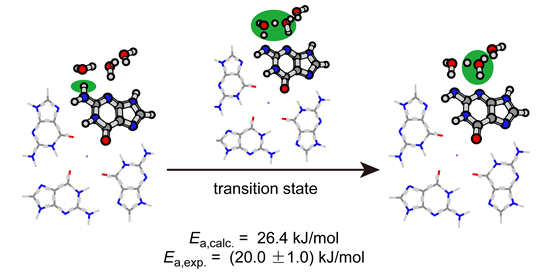| [1] Hall, D. B.; Holmlin, R. E.; Barton, J. K. Nature 1996, 382, 731.
[2] Wang, X. X.; Gu, Y.; Chen, D. X.; Fang, Y. F.; Huang, Y. P. Acta Chim. Sinica 2010, 68, 2463. (王晓星, 顾彦, 陈登霞, 方艳芬, 黄应平, 化学学报, 2010, 68, 2463.)
[3] Lu, Y. M.; Ou, Z. B.; Hu, W.; Le, X. Y. Acta Chim. Sinica 2012, 70, 973. (卢艳梅, 区志镔, 胡伟, 乐学义, 化学学报, 2012, 70, 973.)
[4] Shao, B.; Mao, L.; Qu, N.; Wang, Y.-F.; Gao, H.-Y.; Li, F.; Qin, L.; Shao, J.; Huang, C.-H.; Xu, D.; Xie, L.-N.; Shen, C.; Zhou, X.; Zhu, B.-Z. Free Radical Biol. Med. 2017, 104 (Suppl. C), 54.
[5] Kawai, K.; Majima, T. Acc. Chem. Res. 2013, 46, 2616.
[6] Endres, R. G.; Cox, D. L.; Singh, R. R. P. Rev. Mod. Phys. 2004, 76, 195.
[7] Okamoto, A.; Tanaka, K.; Saito, I. J. Am. Chem. Soc. 2003, 125, 5066.
[8] Barnett, R. N.; Cleveland, C. L.; Joy, A.; Landman, U.; Schuster, G. B. Science 2001, 294, 567.
[9] Giese, B. Acc. Chem. Res. 2000, 33, 631.
[10] Faraggi, M.; Broitman, F.; Trent, J. B.; Klapper, M. H. J. Phys. Chem. 1996, 100, 14751.
[11] Cleveland, C. L.; Barnett, R. N.; Bongiorno, A.; Joseph, J.; Liu, C. S.; Schuster, G. B.; Landman, U. J. Am. Chem. Soc. 2007, 129, 8408.
[12] Kawai, K.; Osakada, Y.; Majima, T. ChemPhysChem 2009, 10, 1766
[13] Kobayashi, K.; Yamagami, R.; Tagawa, S. J. Phys. Chem. B 2008, 112, 10752.
[14] Wu, L. D.; Liu, K. H.; Jie, J. L.; Song, D.; Su, H. M. J. Am. Chem. Soc. 2015, 137, 259.
[15] Candeias, L. P.; Steenken, S. J. Am. Chem. Soc. 1989, 111, 1094.
[16] Candeias, L. P.; Steenken, S. J. Am. Chem. Soc. 1992, 114, 699.
[17] Kobayashi, K.; Tagawa, S. J. Am. Chem. Soc. 2003, 125, 10213.
[18] Steenken, S.; Reynisson, J. Phys. Chem. Chem. Phys. 2010, 12, 9088.
[19] Ceron-Carrasco, J. P.; Requena, A.; Perpete, E. A.; Michaux, C.; Jacquemin, D. J. Phys. Chem. B 2010, 114, 13439.
[20] Takada, T.; Kawai, K.; Fujitsuka, M.; Majima, T. Proc. Natl. Acad. Sci. U. S. A. 2004, 101, 14002.
[21] Choi, J.; Park, J.; Tanaka, A.; Park, M. J.; Jang, Y. J.; Fujitsuka, M.; Kim, S. K.; Majima, T. Angew. Chem., Int. Ed. 2013, 52, 1134.
[22] Delaney, S.; Barton, J. K. Biochemistry 2003, 42, 14159.
[23] Szalai, V. A.; Thorp, H. H. J. Am. Chem. Soc. 2000, 122, 4524.
[24] Song, D.; Yang, W.; Qin, T.; Wu, L.; Liu, K.; Su, H. J. Phys. Chem. Lett. 2014, 5, 2259.
[25] Wolter, M.; Elstner, M.; Kubar, T. J. Chem. Phys. 2013, 139, 125102.
[26] Barnett, R. N.; Bongiorno, A.; Cleveland, C. L.; Joy, A.; Landman, U.; Schuster, G. B. J. Am. Chem. Soc. 2006, 128, 10795.
[27] Rokhlenko, Y.; Geacintov, N. E.; Shafirovich, V. J. Am. Chem. Soc. 2012, 134, 4955.
[28] Rokhlenko, Y.; Cadet, J.; Geacintov, N. E.; Shafirovich, V. J. Am. Chem. Soc. 2014, 136, 5956.
[29] Saintome, C.; Amrane, S.; Mergny, J. L.; Alberti, P. Nucleic Acids Res. 2016, 44, 2926.
[30] Wu, L. D.; Jie, J. L.; Liu, K. H.; Su, H. M. Acta Chim. Sinica 2014, 72, 1182. (吴丽丹, 节家龙, 刘坤辉, 苏红梅, 化学学报, 2014, 72, 1182.)
[31] Morikawa, M.; Kino, K.; Oyoshi, T.; Suzuki, M.; Kobayashi, T.; Miyazawa, H. Bioorg. Med. Chem. Lett. 2015, 25, 3359.
[32] Zhao, Y.; Truhlar, D. G. J. Phys. Chem. A 2008, 112, 1095.
[33] Galano, A.; Alvarez-Idaboy, J. R. Phys. Chem. Chem. Phys. 2012, 14, 12476.
[34] Li, J.; Fu, K.-X.; Li, X.-Y. J. Mol. Struct.:THEOCHEM. 2007, 819, 32.
[35] Li, X.; Cai, Z.; Sevilla, M. D. J. Phys. Chem. B 2001, 105, 10115.
[36] Kumar, A.; Sevilla, M. D. J. Phys. Chem. B 2009, 113, 11359.
[37] Horvath, M. P.; Schultz, S. C. J. Mol. Biol. 2001, 310, 367.
[38] Parkinson, G. N.; Lee, M. P. H.; Neidle, S. Nature 2002, 417, 876.
[39] Marx, D.; Tuckerman, M. E.; Hutter, J.; Parrinello, M. Nature 1999, 397, 601.
[40] Berkelbach, T. C.; Lee, H. S.; Tuckerman, M. E. Phys. Rev. Lett. 2009, 238302.
[41] Frisch, M. J.; Trucks, G. W.; Schlegel, H. B.; Scuseria, G. E.; Robb, M. A.; Cheeseman, J. R.; Montgomery, J. A.; Vreven, T.; Kudin, K. N.; Burant, J. C.; Millam, J. M.; Iyengar, S. S.; Tomasi, J.; Barone, V.; Mennucci, B.; Cossi, M.; Scalmani, G.; Rega, N.; Petersson, G. A.; Nakatsuji, H.; Hada, M.; Ehara, M.; Toyota, K.; Fukuda, R.; Ha-segawa, J.; Ishida, M.; Nakajima, T.; Honda, Y.; Kitao, O.; Nakai, H.; Klene, M.; Li, X.; Knox, J. E.; Hratchian, H. P.; Cross, J. B.; Bakken, V.; Adamo, C.; Jaramillo, J.; Gomperts, R.; Stratmann, R. E.; Yazyev, O.; Austin, A. J.; Cammi, R.; Pomelli, C.; Ochterski, J. W.; Ayala, P. Y.; Morokuma, K.; Voth, G. A.; Salvador, P.; Dannen-berg, J. J.; Zakrzewski, V. G.; Dapprich, S.; Daniels, A. D.; Strain, M. C.; Farkas, O.; Malick, D. K.; Rabuck, A. D.; Raghavachari, K.; Foresman, J. B.; Ortiz, J. V.; Cui, Q.; Baboul, A. G.; Clifford, S.; Cioslowski, J.; Stefanov, B. B.; Liu, G.; Liashenko, A.; Piskorz, P.; Komaromi, I.; Martin, R. L.; Fox, D. J.; Keith, T.; Al-Laham, M. A.; Peng, C. Y.; Nanayakkara, A.; Challacombe, M.; Gill, P. M. W.; Johnson, B.; Chen, W.; Wong, M. W.; Gonzalez, C.; Pople, J. A. Gaussian 09, Revision A. 01, Gaussian, Inc., Wallingford, CT, 2009. |
